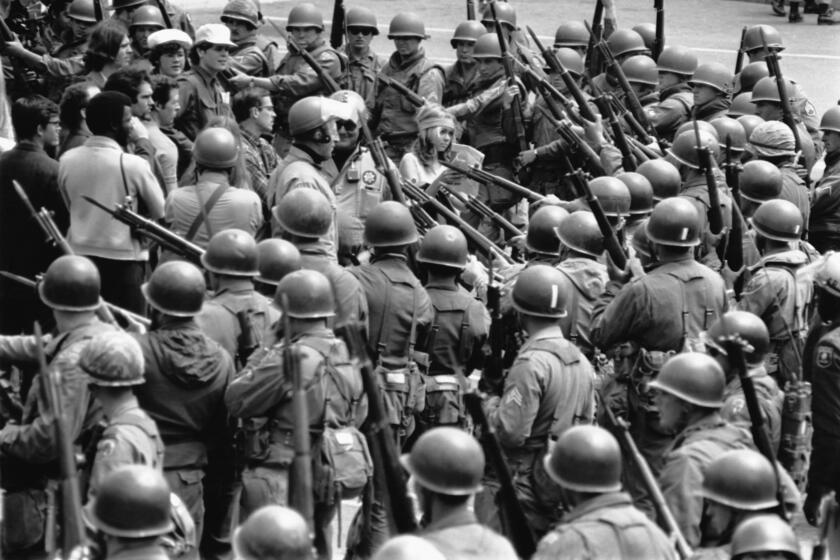Prosecutors Assail Bird and 2 Fellow Justices
The reasons to defeat Chief Justice Rose Elizabeth Bird and two other liberal justices of the state Supreme Court can be found in the grisly record of murders, rapes and robberies that have sent 177 men to San Quentin’s Death Row, but none to the gas chamber, the state’s prosecutors argue.
In a case-by-case broadside against the court’s brand of justice, the California District Attorneys Assn. accused the three jurists of having “waged a continuous attack on the death penalty” despite the chilling crimes that have passed before them.
A spokesman for Bird, however, said the chief justice was “absolutely” prepared to vote for the death penalty. “If it passes muster, she will vote for it without any question,” said Anthony Murray, former state Bar president and spokesman for Bird’s Committee to Conserve the Courts. “But she will not retreat from her responsibility to make certain it is constitutional.”
Murray and other Bird supporters argued that the California Supreme Court was really no slower in implementing capital punishment than courts in other states.
As seen through the eyes of prosecutors, the report by the district attorneys is designed to support their decision last February to oppose Bird and Justices Cruz Reynoso and Joseph P. Grodin, who are among five members of the Supreme Court up for reelection in November, 1986. The report, a draft of which was obtained by The Times, is to be released today.
In addition to the death penalty, the report accused the Bird court of bias in favor of defendants in all kinds of criminal cases and said it was guilty of “an unremitting assault on law enforcement.” The district attorneys also accused the chief justice of “packing” the Supreme Court by inviting judges who share her ideological views to temporarily fill in on the high court for justices who are absent.
Bird, Reynoso and Grodin are the only justices ever to face organized opposition from the district attorneys’ group, which has a membership of 2,100 among about 2,500 prosecutors in the state. The injection of electoral politics into the association has been criticized by some court supporters, and there has been speculation in legal circles that the group may be risking its tax-exempt status by getting involved in the court election.
The so-called White Paper focuses in detail on 33 death penalty appeals heard by the court since the reinstatement of capital punishment in 1977, including one that made its way to the justices twice. All but three of the death sentences were reversed but the cases remain in various stages of continued appeal.
The 33 cases are known to the public through news accounts over the last half-dozen years. But packaged together into what the association called “a truly terrible list of murderers,” the report seemingly is designed to shock and thereby call into doubt the legal reasoning used to decide death penalty appeals.
Here are two case synopses from the report:
- “In People vs. Easly, once again Justices Bird, Reynoso and Grodin joined to reverse a death penalty case. Easly was a professional hit man who killed a man and woman in a corporate assassination. The man was stabbed over and over with an ice pick, in the face, the ears, and his torso. The woman died from stab wounds from the ice pick and suffocation from a rubber ball stuffed in her mouth. Bird voted to reverse Easly’s conviction because . . . the jury was not told it could consider sympathy for the defendant.”
- “Ronny Mozingo was sentenced to death for raping his stepmother and then hogtying her with electrical cord in such a way that she would strangle herself as her legs tired and drooped. Mozingo positioned himself so that the dying woman would have to watch him for the whole painful time she slowly choked to death. It was a terrible death. Because the cord constricted her blood flow, the increasing pressure caused veins to rupture as her lungs, filling with air and unable to empty, also burst. By arching and twisting, the woman was able, at the last moment, to turn away when she died so she did not have to see Mozingo. . . . Mozingo expressed disappointment later that he had been deprived of seeing her dying moment. His conviction was reversed . . . for ineffective assistance of counsel.”
Murray argued that the report was nothing more than “the work of a special-interest group interested not in the needs of the system of justice but in winning all these cases.”
Moreover, Murray argued, no executions have taken place in more than two-thirds of the states, which, like California, have reinstated the death penalty and are reviewing the constitutionality of their laws.
The 33 death penalty cases produced a variety of split votes, with conservatives sometimes siding with liberals to reverse death sentences. The district attorneys, however, said the voting patterns of the three targeted justices proved their “pronounced antipathy toward the death penalty in spite of its deep public support and legal and moral justifications.”
By the count of the prosecutors, Bird voted against the death penalty in all 33 cases. Reynoso, the only Latino on the high court, sided against it in 21 of 22 cases on which he sat. Grodin voted against it in 18 of 18 cases.
Delay Decision
One justice who is not opposed by the district attorneys is Malcolm M. Lucas, who also is the only member of the court appointed by incumbent Gov. George Deukmejian, a popular figure in law enforcement circles. The final justice up for election is Stanley Mosk, who has indicated that he might retire rather than seek another 12-year term. The district attorneys said they would not decide whether to oppose him until he declared his candidacy.
The district attorneys’ report complained of growing delays in death penalty appeals, saying that the most recent five capital cases took the high court 1,485 days from trial court judgment to decision.
“Even if no more death penalty appeals were sent to the Supreme Court, it would still take until the year 2015 for the cases stalled before the court to be finally decided,” the report said. “In other words, every Death Row inmate will have died of old age before the California Supreme Court under Bird renders a decision in his case.”
The law requires that death penalty appeals be decided no more than 150 days after the trial court record is certified. The district attorneys’ report said this is “utterly ignored” by the Bird court. The prosecutors complained, for instance, of long delays in certifying court transcripts in order to correct spelling errors.
Speaking for Bird, Murray said the delays could not be avoided. “These justices have done everything they can to speed up and streamline the process, and the district attorneys know it.”
Singles Out Bird
One chapter of the prosecutors’ report singles out Bird for special criticism. Drawing from the chief justice’s own decisions, the report suggests how Bird “would change California criminal law.” Here are a few examples:
- “If the jury foreman accidentally signs the wrong verdict forms, the burglar goes free.”
- “The killing of a hostage who is being used as a shield by a robber to effect escape is not murder unless the robber himself commits the killing.”
- “A death penalty jury must include people who say they do not know if they could follow the death penalty law.”
The report by the district attorneys group is bound to attract interest and attention because Bird and her allies have been successful, at least until now, in painting court opponents as fringe politicians. It will be more difficult to dismiss the prosecutors that way.
As Ventura County Dist. Atty. Michael D. Bradbury, president of the association, said in an introduction to the report: “Voters can only determine if a justice is exercising his or her discretion fairly and free of bias by examining the judicial decisions. In order to make an intelligent choice, the voters must turn to the record of the justices.
Reason for Comment
“The records of public officials in the executive and legislative branches are more accessible to the public than those in the judiciary. That is why it is important that those who have examined it closely and who must work with it daily comment on that record.”
But Murray complained that the district attorneys were seeking a new kind of justice based on changing public passions--”Gallup Poll justice,” he called it.
“The obligation of a court is to see that a law is constitutional, not that it is popular with the people.”
More to Read
Start your day right
Sign up for Essential California for news, features and recommendations from the L.A. Times and beyond in your inbox six days a week.
You may occasionally receive promotional content from the Los Angeles Times.






